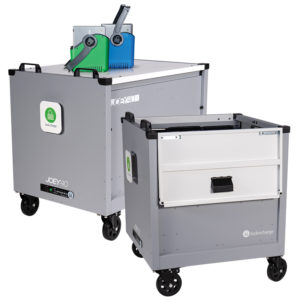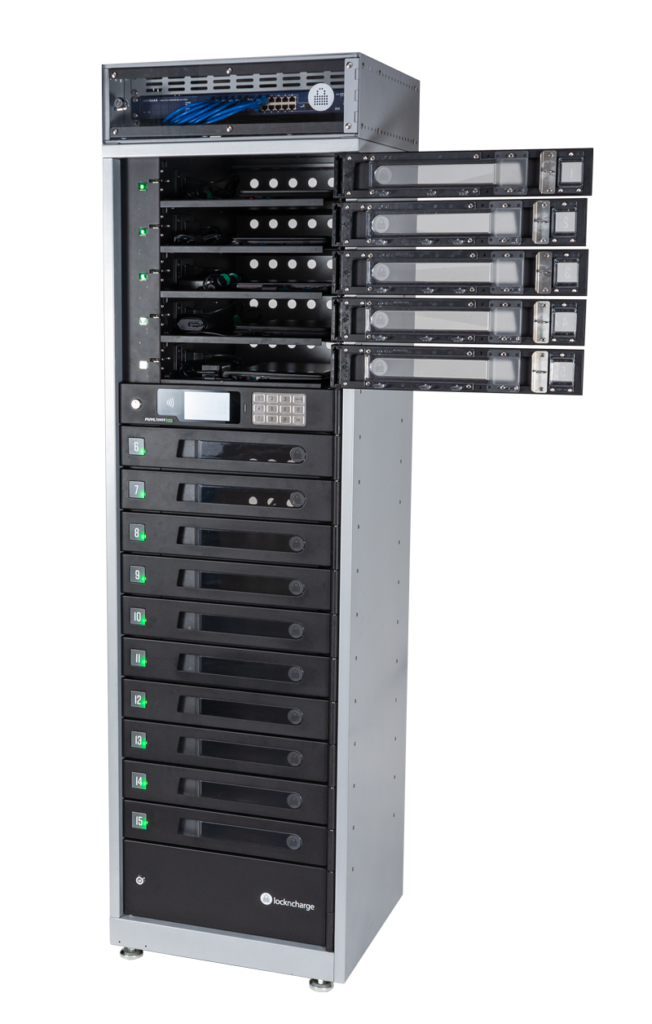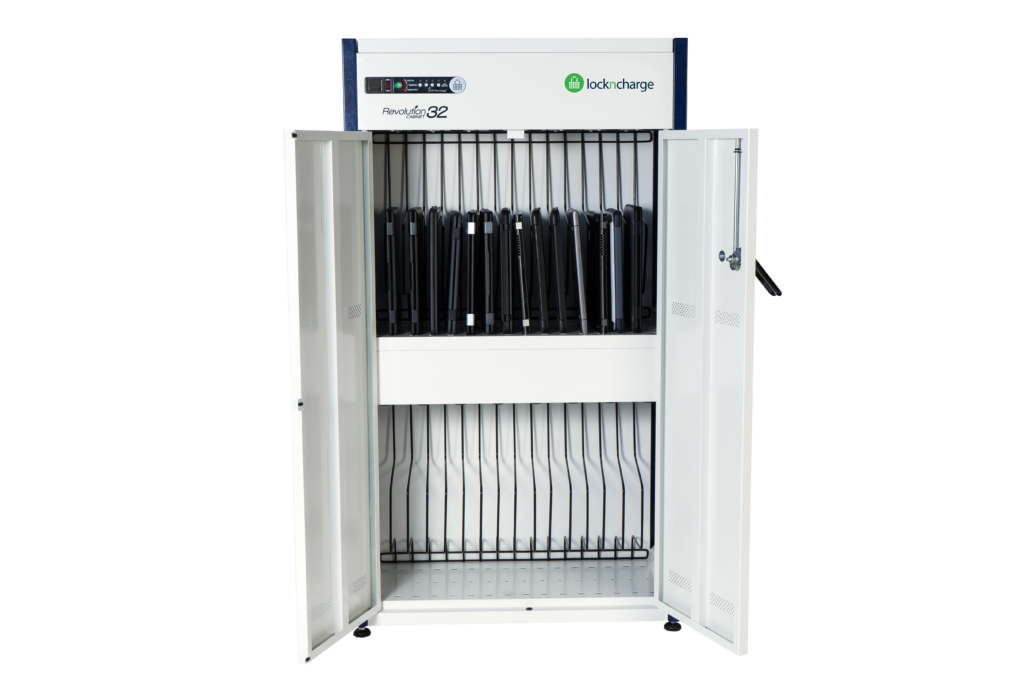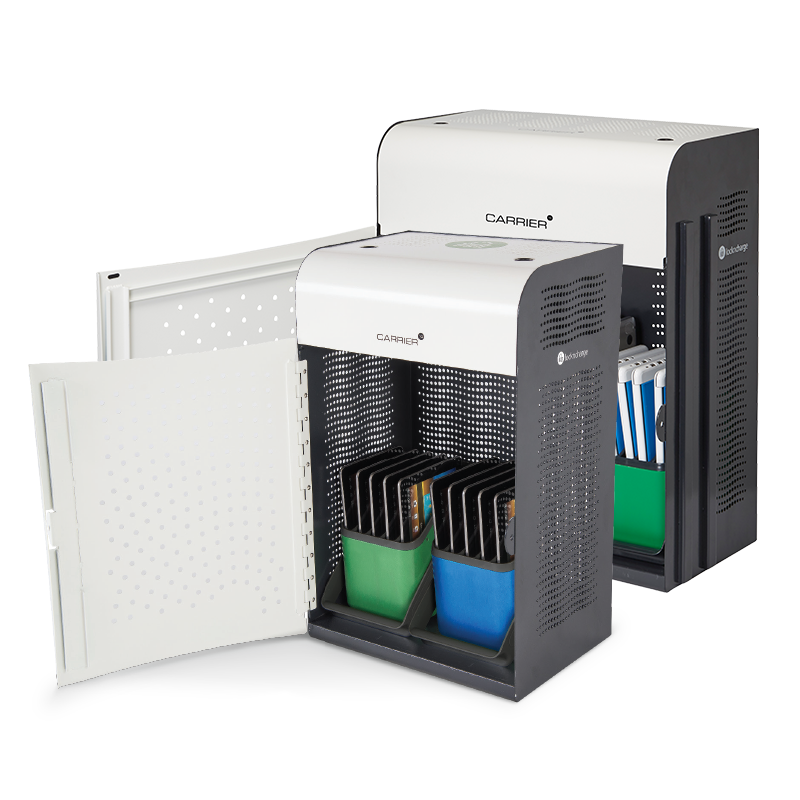The Best Charging Stations for Multiple Devices
At LocknCharge, we are dedicated to designing and manufacturing the highest quality charging stations for multiple devices for any mobile device program.
Our mission is to make life easier for schools and organizations implementing mobile device technology for multiple devices–including tablets, laptops, iPads and MacBook devices. If your school or organization has a number of devices to maintain and manage, you know how difficult it can be to find a charging solution or management system that works.
Cords can get tangled, devices become lost or stolen, a limited number of outlets can lead to a counterintuitive technology plan and device management for broken devices is compounding. With 73% of businesses failing to find a proper charging station for their technology, these problems are more common than you may think!
Best Multiple Device Charging Stations
We’ve rounded up some of our best charging stations, smart lockers and charging carts to meet the needs of multiple device types.
1. Joey Charging Carts
Affordability meets functionality.
Our Joey Carts are an affordable option for any school or business looking to charge multiple devices. The design of this Cart accommodates both racks and Baskets so you can charge up to 30 or 40 of just about any device with a 17” screen size.
Not only is the cart small and compact in size, but it also takes only minutes to wire the entire Cart. Plus the power strips are now more easily accessible, so you no longer have to wrestle with tangled cords. There’s plenty to love about this cart! Check it out here.
2. FUYL Smart Locker System
The FUYL Smart Locker System takes hardware asset management to the next level.
The FUYL Smart Charging Locker System is an Intelligent Hardware Asset Management System that charges, stores, secures and manages assets for most mobile devices in 15 individually-lockable compartments. FUYL Towers are powered by LocknCharge Cloud to remotely manage physical assets secured inside the Tower.
This smart charging locker has 5 or 15 individually-lockable compartments, each equipped with a power outlet and a 2.4 amp USB port. You can manage almost any device, including iPads, tablets, laptops, mobile phones, Chromebooks and more. Learn more about the FUYL Smart Locker System here.
3. Carrier Charging Carts
Carrier 20, 30 and 40 Carts provide ultimate security and durability.
Secure, efficient and a future-proofed, Carrier 20, 30 and 40 Carts sound almost too good to be true, right? Well, these Carts live up to the task. With the option for either racks or baskets, Carrier Carts accommodate almost any device up to 17”. Remove the racks or baskets to create an open-concept design that can also hold other technology such as robotics, printers, drones and more.
Our Baskets by LocknCharge hold five devices and make device deployment quick and easy. The top-loading design ensures easy access to devices–no more bending down to gather devices on a bottom shelf. And with cabling stored in the bottom of the Cart, power bricks and cords stay organized and will never go missing. Learn more about Carrier Carts here.
4. Revolution 32 Charging Cabinet
Charge a greater number of devices in a small footprint.
This charging cabinet can accommodate 32 devices up to 17 inches, with or without a case while taking up 50% less floor space than a traditional charging cart.
For 1:1 classrooms that are tight on space but need to charge, store and secure a greater amount of devices, the Revolution 32 Charging Cabinet is just the ticket. And with ECO Safe Charge Power Management, you can easily charge 32 devices in the same amount of time as just one. Learn more here.
5. Carrier Charging Stations
Carrying you to better charging solutions, one station at a time.
Limited on space? No worries - with our Carrier Charging Stations, you can make any wall or desk a secure charging station for anywhere from 10 to 15 devices.
This charging station for multiple devices also comes equipped with Baskets, making deployment of devices up to 13” faster and easier. And for devices up to 17”, swap the Baskets for Racks to easily accommodate larger devices. Still not convinced? Charge your devices while they’re safely locked, giving you back classroom and work time. Check out the station here.
Deep-Dive Webinar: LocknCharge Smart Locker and Incident IQ Help Desk Integration
Incident IQ and LocknCharge are revolutionizing how school districts manage mobile devices and support K-12 device workflows.
Watch this webinar to see the integration between these two systems in action.
When integrating the Incident IQ platform with the FUYL Smart Locker System from LocknCharge, schools can experience seamless end-to-end management of devices. When a student, teacher, substitute or other faculty member needs a replacement or loaner device, it can be assigned to them via the Incident IQ platform and picked up from a FUYL Tower Smart Locker. Automating this process gives end users a working device in minutes without derailing the tech team.
Schedule a Live Product Demo
Schedule a live video demo with a LocknCharge team member to get a closer look at how our products help make your life easier.
Connected Devices, Streamlined Learning: Smart Charging Lockers Help Students Avoid Device Downtime
A look at how device downtime hurts student learning – and what to do about it.
In the US alone, Education Week found that 84% of elementary schools and 90% of middle and high schools have adopted one-to-one device access for students. Furthermore, during a November 2022 survey of 171 US-based teachers, LocknCharge discovered that 59% of teachers require the use of a device during class three to five times per week on average — and 55% of teachers require the use of a device at home at least one time per week on average. These findings demonstrate the dependence on device usage for student learning.
59% of teachers require the use of a device during class 3-5 times per week on average.
55% of teachers require the use of a device at home at least once per week on average.
As more schools see the benefits of equipping students with devices, these costs are becoming a permanent part of the school budget. However, putting the right systems in place can go a long way toward helping schools operate technology efficiently and effectively.
As a result, schools are now undergoing a regular “computing device return-and-repair ritual,” EdSurge reports. In Atlanta, lost or damaged devices cost the public school system $3.5 million in one year, with about 11% of devices issued to students never returned.
The benefits of keeping devices charged, safe and operational can’t be understated: Technology is helping to prepare today’s students for tomorrow’s workforce, and it is ushering in a new era of personalized instruction that helps improve outcomes for all students.
All over the country, school districts are going to great lengths to keep devices working at peak performance — knowing full well that if they do not, teachers may ditch them altogether, reverting to pen and paper, EdTech Magazine reports.
Given these risks, schools should take the effects of lost and broken devices seriously.
The Challenge of Device Downtime
Learning outcomes are greatly affected when a student or teacher doesn’t have a working device in hand for instruction, class participation or homework. When an electronic device used for learning breaks or has any other downtime issues, the student is quite literally locked out of their learning resources — plus, there are other classroom implications when devices aren’t available.
In fact, the same November 2022 LocknCharge survey revealed that 57% of educators are helping to replace student devices at least one time per week on average, taking time away from teaching.
57% of teachers are assisting students with replacement or loaner devices at least one time per week on average.
In addition, of the educators surveyed, 63% stated that students who do not have a working device at school experience lost learning time.
63% of teachers site lost learning time for students who don't have access to a working device for class.
There is also the issue of device and data security, which is more difficult to manage when students are using their own devices, or those of parents. A school-issued device maintained with security and data protection in mind is a safer one, both for the student and the district. Data and other security falter when a student has to fall back on a home-sourced device.
And what happens when that device is lost? Just take the massive security breach of Illuminate Education in January 2020, for example. It has raised questions about the safety and security of student data in this new era, and that makes it more important than ever for schools to adopt security measures for devices. All of this is more easily managed through school-issued devices, and having backups readily available.
Real-World Examples of Keeping Students Online, Protected
In the past, minimizing the effect of student device downtime has been a challenge, but thankfully, tech-savvy districts are finding ways to greatly reduce the problem.
Oklahoma’s Moore Public Schools
Instruction at Moore Public Schools in Oklahoma is spread across 36 sites and about 136 square miles. The costs of managing a 1:1 device system can quickly add up when it can take a 30 minute drive to deliver a device to a teacher or student. And when parents are asked to drive that distance to pick up devices for their children, equity concerns emerge that could leave some families without access to the technology needed for students to excel in school.
Earlier this year, the school system began piloting LocknCharge’s FUYL Smart Locker System and the Incident IQ Help Desk ticketing system integration to better manage their device infrastructure and offer students a way to easily access devices when they need them.
The smart charging lockers are placed in high school and college media centers, for example, where staffers and students can check them out as needed.
Now, rather than trade emails back and forth with a student to schedule a broken device exchange, the technology team can remotely issue a device to that student via one of its FUYL Towers. Students can quickly and easily swap out the broken device for a new one at their convenience.
"The goal is to be close to zero downtime for any event that takes students and teachers away from engaging and effective learning."
– Jun Kim, Director of Technology, Moore Public Schools
“This level of technology operations is a must-have in today’s learning environments,” says Jun Kim, Director of Technology at Moore Public Schools. “The goal is to be close to zero downtime for any event that takes students and teachers away from engaging and effective learning,” Kim says. “It’s essential to utilize technology as a tool to help increase our student achievement and to help prepare those students to thrive in that digital college or digital career environment.
Smart Lockers Help Schools Manage Devices Efficiently
Automation technology is making it possible to reduce the time technology departments must spend addressing issues such as damaged and lost devices.
When it comes to designing products for educational settings, LocknCharge has more than 20 years working directly with school districts to meet their needs. The company is the leading global manufacturer and supplier of mobile deployment solutions with headquarters in Australia, the USA, Europe and Japan.
Los Angeles Unified School District
Recently, the Los Angeles Unified School District, the second-largest system in the US, turned to LocknCharge for autonomous checkout smart lockers, so students and educators can access charged and ready-to-use devices more conveniently.
LAUSD’s decision to add up to 1,800 LocknCharge FUYL Tower Smart Lockers was originally prompted during the COVID-19 shutdown. The district needed a way to distribute devices safely to students and parents in a manageable way.
“After vetting different vendors and companies, we felt that LocknCharge was the best fit and product option for the district,” said Phillip Lucero, Senior IT Business Efficiency Analyst at LAUSD.
What started as a solution to a device management crisis has morphed into an in-person assist, too. LAUSD students and teachers rely on the LocknCharge lockers to reduce in-person downtime from lost, forgotten or broken devices.
“Reducing device down time for students and teachers means more classroom interaction for students. Device down time means less classroom instruction, and the students lose valuable class learning experience,” Lucero said.
— Phillip Lucero, Senior IT Business Efficiency Analyst, LAUSD
School districts of all sizes can benefit from what LocknCharge offers, from a single locker to hundreds, with features such as overseeing bay reservations remotely, locker usage reports, external user directory integration and external ticketing system integrations. At Moore Public Schools, Kim says working with LocknCharge has offered “amazing” results.
“They look at how they can incorporate a technology or tool to make it more efficient with the school and classroom in mind,” Kim says. “The biggest challenge when it comes to devices is that accidents happen,” Kim notes.
Kim’s team has established a process to address that, from steps teachers can take to troubleshoot devices to ways they can easily swap out devices when they require repair.
Without an automated process, the district would “definitely increase time and energy,” Kim says, and take away from time that could be spent resolving other issues.
Oregon’s Beaverton School District
The Beaverton School District in Oregon serves over 60,000 students. The schools rely heavily on an online learning management system for its curriculum, meaning students must have access to technology at school and at home, explains Mac McMillian, the district’s Administrator for Information & Technology.
“In most cases, without the technology, they cannot complete their work,” McMillian points out.
The biggest challenge is in classrooms, which were not built with the idea that every student needs access to a charging port.
“We have to rely on the students to arrive at school with a charged device or have a stockpile of loaner devices for them to complete their work,” McMillian says.
At the onset of the pandemic, Beaverton School District invested in 10 LocknCharge FUYL Tower Smart Lockers to provide students a contactless way to exchange devices during remote learning. Now, those smart charging lockers are serving as charging stations and lockers for safe storage overnight when students don’t need to take devices home. They also house backup devices that are checked out when students experience breakage or other issues that slow down their connected learning.
McMillian says the district hasn’t yet quantified the savings from their deployment of smart lockers, but the qualitative benefits are evident.
"The towers at the central office are saving a significant amount of time."
— Mac McMillian, Administrator for Information and Technology, Beaverton School District
“The towers at the central office are saving a significant amount of time for both our staff assigned to the central office and to those needing to retrieve or drop off equipment or materials. They no longer have to wait for someone to come meet them, they can securely drop it for them, and our central staff can pick it up at their convenience knowing exactly where it is located,” McMillian adds.
Conclusion: Minimizing Learning Disruptions and Managing Devices More Efficiency
The shift toward technology-driven education is an unstoppable phenomenon that preceded the pandemic and has been expedited as a result of it. Many districts see the potential to improve learning and better equip students for the future by availing the benefits of devices.
Yet the maintenance, oversight and replenishment of these devices is a significant new cost for districts that can serve as an impediment. That’s why it is crucial for technology teams to put the systems in place to minimize learning disruptions and manage devices efficiently.
To download a PDF of this story, click here.
About LocknCharge
LocknCharge is a software and hardware company that is revolutionizing the way organizations manage mobile devices and other physical assets. During their 20+ years of experience, they’ve come to understand many of the challenges organizations face with device management.
LocknCharge exists to help schools and businesses uncover a better way to manage devices with less oversight, secure devices from theft, and minimize device down time. Their portfolio of Cloud-Connected Smart Lockers will not only save time, money and other resources — they will also make your life easier.
Want to learn more?
Schedule a discovery call to learn how Smart Lockers can help your school or district.
Elizabeth Gregory Home and LocknCharge Team Up to Provide Security to Women Facing Hardship
LocknCharge Saves the Day, Every Day
Written by Ally Baehr - Executive Director, Elizabeth Gregory Home
Imagine, if you will, that you are a woman living outside, only able to keep what you can comfortably carry, being very susceptible to having your belongings stolen and your body violated. Sleeping outside is nearly impossible when your safety is consistently being threatened. Your cell phone or other device is your lifeline. It is how you can connect to resources, family and friends, a flashlight, a way to get emergency help, a place to keep important information, how potential employers can reach you, etc. Yet, when you’re experiencing homelessness, your options for charging your device are slim, and you certainly can’t plug it in and fall asleep, because your device will be gone when you wake up, even in shelter.
Elizabeth Gregory Home is a Day Center in north Seattle that provides a welcoming and respectful refuge where women who are experiencing homelessness, hardship and trauma have access to compassionate care. In our Day Center, we provide a variety of services to help make things a little bit easier. We have safe spaces to sleep, take showers, do laundry, get a hot breakfast and lunch, food to take, bus passes, hygiene supplies, clothing, use lockers, and get case management.
But even providing this safe space to do all these things, trust is still hard to gain. After all these women have been through, they are not going to leave their devices plugged into the wall while they sleep or shower. Unfortunately, we can’t completely prevent theft in our space, and that is where LocknCharge comes in and saves the day.
We did a preliminary search for options to meet this need, but were quickly discouraged by the cost as a small nonprofit organization. I hesitantly reached out the LocknCharge to see if there was anything they could do to reduce the cost. Not only did they respond quickly and with enthusiasm, they said they had a unit that had recently been returned and that we could have it, free of charge. We were ecstatic and so incredibly grateful!
LocknCharge has given us the best option to meet the needs of the women we serve. Women can safely lock their devices in our secure LocknCharge Charging Locker and finally get some good rest, be able to step away from their device and take a shower – and not worry about it getting stolen. They can pick their own code, the locker resets after each user, and women are able to fully charge their devices before they leave for the night, giving them just a little extra boost of safety and security.
LocknCharge’s solution has allowed us to add another service to our Day Center, and anything we can do to help these women get through the most difficult time of their lives is essential for us to invest in. These women deserve that investment as we do our work with Respect, Inclusion, Community, and Empathy, the values we instill in our team and our work. Thank you to the LocknCharge team for your support and this brilliant solution.
10 Tips for Maximizing your School’s Time and Tech Budget in 2023
The Current State of Education
Educators are still reeling from the impact of the pandemic, and staffing shortages in schools are causing disruptions to the education sector throughout the world. In the UK, trainee recruitment was reported to be down by 25,000 compared to 2021. In Australia there is an ‘exodus’ from the profession. While in the US, some districts are reporting ‘catastrophic’ teacher shortages. This shortage places greater reliance on retained teaching staff as well as technology to keep the curriculum on track.
Spending on educational technology increased significantly during the epidemic. Estimates suggest spending in the US could have peaked at as much as $56 billion, but in an economic climate of rising inflation and interest rates, budgets are almost certainly going to shrink.
This poses two significant questions for school administrators:
1. How to manage a shrinking tech budget when schools have become dependent on the solutions tech provides.
2. How to improve processes and find inefficiencies in your tech stack when time and attention is consumed by “keeping the boat afloat”.
In an environment where time has become an equally scarce resource to funding, small improvements to process or resource allocation can often make a big impact.
For over 20 years, LocknCharge has listened to and come to understand many of the challenges that educators, tech teams and administrators are facing when implementing or managing technology in their schools. We have aggregated 10 ideas – derived from our conversations with customers, partners, resellers, edtech software and hardware companies and countless others – to help you make the most of your limited time and technology budget.
Top 10 tips to help make the most of limited time and technology budget
1. Let credible organizations vet your education tech for you.
What could be better than taking the time and legwork out of evaluating edtech solutions? Leveraging experienced professionals to do it for you. The team behind Edtech Evidence Exchange is made up of non-affiliated ex-teachers and researchers who document insights that help PK-12 classrooms uncover which edtech tools are working and why.
Their research shows: “Educators estimate that 85% of edtech tools are poor fits or poorly implemented.” Which is why they support decision makers and offer a variety of services to help educators make better-informed choices – which leads to a better use of resources.
2. Start a student-led help desk.
Starting a student-led help desk is a win-win for students and schools. These programs encourage students to engage with the software and hardware they are using to learn but from an IT perspective. The result is that the school benefits from a cost-effective, home-grown IT resource, the student is empowered to nurture an interest that could develop into a future career, and the IT industry develops a pipeline of potential talent.
Dell Technologies is investing in the Dell Student TechCrew program which supports schools with their student-led help desk initiative. As part of this program, some schools are also implementing Smart Lockers as a total device management solution for tech teams in schools. Smart Lockers offer students the opportunity to write webhooks, software integrations and more – while providing a better way to get devices into the hands of end users.
3. Use other schools as a resource.
Engaging with schools that share the same challenges around resource allocation, tech investments and hardware/software management can often provide a shortcut to finding the best tech solutions. Sharing experiences and effective outcomes is a free resource which comes with the added benefits of peer endorsement and real-world case studies.
Take note of the edtech tools you’re using, and look for programs or user groups focused on enhancing those resources. For example, Ribblesdale High School the UK is a Microsoft showcase school. They are dedicated to helping other schools around the world maximize Office 365 and the accessibility tools used to support teaching and learning.
4. Leverage relationships with reseller reps and vendors.
When it comes to ground-floor insight, your reseller reps and vendors can offer access to a wider network of both business and IT expertise. They can provide you with connections to schools in their network with similar challenges or to the right partners who have the best solution to your problem. In a competitive marketplace, most vendors will be adding value to their offer by providing supplementary services that complement their products. By using reseller reps and vendors as a resource, educators have access to a broad range of experience with products, support and implementation.
5. Invest in automation.
Automation is not only at the forefront of tech development – but is at the center of saving administrators’ significant time. Consider the incremental benefits automation software can provide for student onboarding, grading, scheduling classes, and much more.
This concept stretches to edtech hardware, too. Imagine onboarding daily substitute teachers with an automated process using smart charging lockers. Student or teacher onboarding throughout the school year can be streamlined in the same fashion.
Or envision an automated broken device exchange program where students can replace their broken device with a loaner in just seconds, without IT oversight.
6. Select flexible, forward-thinking software and hardware.
Administrators take great responsibility for the purchases they make, which is why future-proof technology is central to astute edtech selection. Choosing the right software and hardware can save endless hours and dollars if compatible with systems of the future.
For example, Google classroom can be integrated with free educational apps that extend the platform’s capabilities.
Integrations can also enable cloud-connected hardware solutions such as Smart Lockers to automate mobile device management with the least amount of friction possible – providing time saving for IT teams and devices users alike. With easy-to-use, open API, tech teams can maximize their investments by seamlessly integrating software, such as a help desk ticketing system, to get the most out of each individual component.
7. Outsource IT where it makes sense.
It is not just teaching staff that are at a premium and under time pressure within education settings. IT teams are equally stretched, so considering an outsourced IT capability might make perfect sense. Finding a suitable partner is not as difficult as it may seem – as some resellers offer ‘white glove’ services, making it easier for you to get tech up and running in your schools. This can include imaging devices, cabling carts or stations, hardware installation, asset tagging and more.
Managed Service Providers (MSPs) offer end-to-end implementation services – all under one roof. Consolidating services to one provider brings tech expertise, flexibility, security and crucially – cost efficiencies.
8. Simplify and streamline your device management processes.
A centralized approach to managing devices allows teachers and administration to have confidence that hardware is accessible and ready to go when needed. Laptops and tablets that are updated, charged and securely stored ensure classes run seamlessly, even when a student’s device is forgotten, lost or broken. Loaner devices can be centrally stored and managed inside LocknCharge’s FUYL Tower Smart Lockers powered by LocknCharge Cloud.
Including device management protocol as part of teacher on-boarding ensures students aren’t missing out on lessons simply because they don’t have a working device.
9. Stay ahead of the storm by repurposing already-available resources.
It is difficult to predict adversities such as teacher shortages, but it is almost guaranteed that staffing issues will be a problem during the 2023 academic year.
Using tech to mitigate the impact of these absences maximizes the investment made in the technology. Consolidating lesson plans, onboarding processes and teaching resources onto platforms and apps that can be shared with substitutes – and remotely imaged onto mobile devices – has immediate benefits to staff and students alike.
Remote learning was not the ideal environment for many students, but remote teaching methods that were refined during that time can be transferred to in-person learning. One innovative computing teacher found his recorded lessons created during remote learning work well for cover lessons. Now a cover teacher or sub can keep his students on-track even in his absence.
10. Invest in modernization.
Keeping legacy tech as long as possible may be driven by budget constraint, but the continued use of out-of-date systems requires more time (and money) to keep them viable. For example – shifting from desktop software to subscription-based, cloud software ensures students are working in the most up-to-date programs. Automatic security patches are also critical to keep student data and school networks secure.
As a general rule – modernization of software, hardware and IT infrastructure are key steps in future-proofing a technology strategy.





